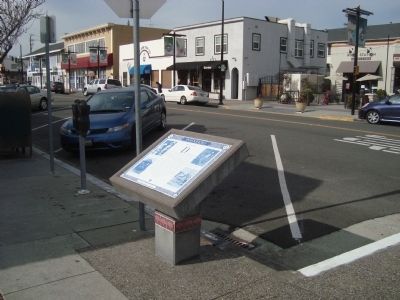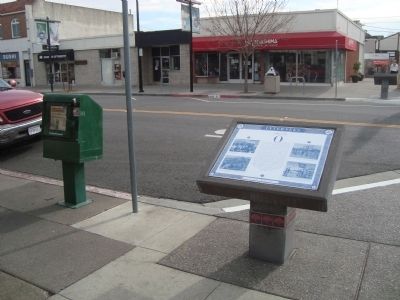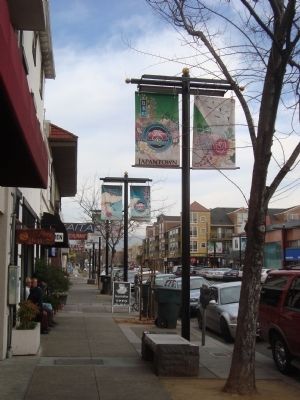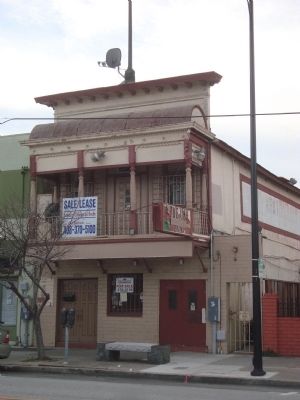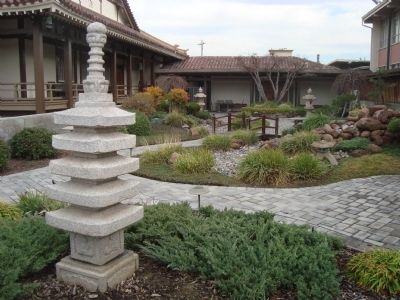Central San Jose in Santa Clara County, California — The American West (Pacific Coastal)
Nihonmachi
[Japantown]
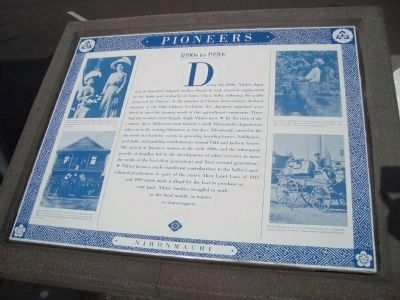
Photographed By Barry Swackhamer, January 30, 2012
1. Nihonmachi Marker - Pioneers (Panel 1)
[Photo captions, clockwise from the top left:]
New arrivals Mrs. Kinura (l) and Nonoshi Miwa (r) pictured here in c.1907. Issei women worked in the valley’s fields and canneries, contributing significantly to the family’s income. (Photo courtesy of Joe Y. Akahoshi)
Issei pioneer Yuwakichi Sakauye, picking pears. Mr. Sakauye and many other Nikkei farmer’s developed new varieties of fruit, vegetables, and flowers. (Photo courtesy of Eiichi Sakauye)
Riichi Nishimura at the corner of Sixth 7 Jackson Sts. in 1910 delivering his produce to market. ( Photo courtesy of Hideko Morishita)
Yamato Bathhouse on Sixth St., pictured here on New Year’s Day 1911, was typical of the period, serving the needs of transient men. (Photo courtesy of Kenemoto Collection and California History Center Archives).
New arrivals Mrs. Kinura (l) and Nonoshi Miwa (r) pictured here in c.1907. Issei women worked in the valley’s fields and canneries, contributing significantly to the family’s income. (Photo courtesy of Joe Y. Akahoshi)
Issei pioneer Yuwakichi Sakauye, picking pears. Mr. Sakauye and many other Nikkei farmer’s developed new varieties of fruit, vegetables, and flowers. (Photo courtesy of Eiichi Sakauye)
Riichi Nishimura at the corner of Sixth 7 Jackson Sts. in 1910 delivering his produce to market. ( Photo courtesy of Hideko Morishita)
Yamato Bathhouse on Sixth St., pictured here on New Year’s Day 1911, was typical of the period, serving the needs of transient men. (Photo courtesy of Kenemoto Collection and California History Center Archives).
[This marker is composed of four panels, each located at one corner of the intersection of Jackson and North Fifth Streets in San Jose.]
[Panel 1, south corner]
1890s to 1920s
[Panel 2, east corner]
1920s & 1930s
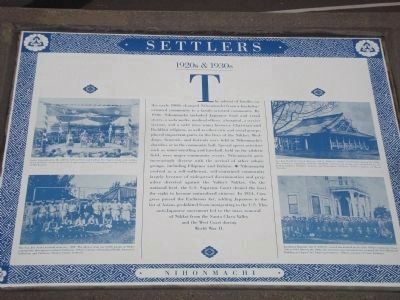
Photographed By Barry Swackhamer, January 30, 2012
2. Nihonmachi Marker - Settlers (Panel 2)
[Photo captions, clockwise from the top left:]
Sumó tournament in the athletic field at Sixth and Jackson Sts. Sports events such as these attracted large crowds and provided opportunities for socializing and revelry. (Photo courtesy of Bill Kogura)
San Jose Buddhist Church Betsuin, 630 N. Fifth St., under construction during the 1930s. This structure, employing authentic Buddhist design, was constructed by two leading builders, brothers Gentaro and Shinzaburo Nishiura. (Photo courtesy of Masuo Akizuki)
Kuwabara Hospital, 565 N. Fifth St., served the medical needs of the Nikkie community from 1910 to 1933. During the 1980s the structure was renovated and renamed the Issei Memorial Building as a legacy “for future generations.” (Photo courtesy of Grant Shimizu)
The San Jose Asahi baseball team in c.1920. The all-star team was widely known in Nikkei communities throughout northern California. (Photo courtesy of Kawahara Family, Kanemoto Collection, and California History Center Archives)
Sumó tournament in the athletic field at Sixth and Jackson Sts. Sports events such as these attracted large crowds and provided opportunities for socializing and revelry. (Photo courtesy of Bill Kogura)
San Jose Buddhist Church Betsuin, 630 N. Fifth St., under construction during the 1930s. This structure, employing authentic Buddhist design, was constructed by two leading builders, brothers Gentaro and Shinzaburo Nishiura. (Photo courtesy of Masuo Akizuki)
Kuwabara Hospital, 565 N. Fifth St., served the medical needs of the Nikkie community from 1910 to 1933. During the 1980s the structure was renovated and renamed the Issei Memorial Building as a legacy “for future generations.” (Photo courtesy of Grant Shimizu)
The San Jose Asahi baseball team in c.1920. The all-star team was widely known in Nikkei communities throughout northern California. (Photo courtesy of Kawahara Family, Kanemoto Collection, and California History Center Archives)
[Panel 3, north corner]
1942 to 1945
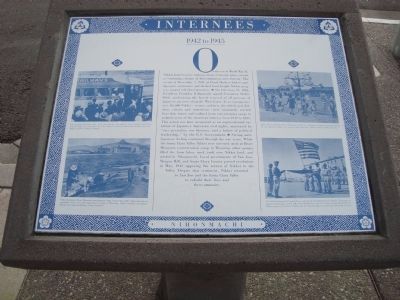
Photographed By Barry Swackhamer, January 30, 2012
3. Nihonmachi Marker - Internees (Panel 3)
[Photo captions, clockwise from the top left:]
Leaving Heart Mountain, May 1943. Although the vast majority were confined until 1945, selected Nikkei were permitted out of the camps to work or continue their college education. (Photo courtesy of Masuo Akiznki)
Obsón religious festival at Heart Mountain in 1943 was celebrated despite the fact that during the war Japanese culture was viewed as anti-American. (Photo courtesy of Masaryi Kastlu)
The 442nd Regimental Combat Team receiving the Presidential Unit Citation. Thousands of Japanese-Americans served with great distinction in the U.S. forces during World War II. (Photo courtesy of Chester Tanaka and the National Japanese-American Historical Society)
Nikkei farming at Heart Mountain concentration camp. Santa Clara Valley Nikkei introduced agriculture into a dry and unproductive region of Wyoming. (Photo courtesy of Sakanye Family and California History Center Archives)
Leaving Heart Mountain, May 1943. Although the vast majority were confined until 1945, selected Nikkei were permitted out of the camps to work or continue their college education. (Photo courtesy of Masuo Akiznki)
Obsón religious festival at Heart Mountain in 1943 was celebrated despite the fact that during the war Japanese culture was viewed as anti-American. (Photo courtesy of Masaryi Kastlu)
The 442nd Regimental Combat Team receiving the Presidential Unit Citation. Thousands of Japanese-Americans served with great distinction in the U.S. forces during World War II. (Photo courtesy of Chester Tanaka and the National Japanese-American Historical Society)
Nikkei farming at Heart Mountain concentration camp. Santa Clara Valley Nikkei introduced agriculture into a dry and unproductive region of Wyoming. (Photo courtesy of Sakanye Family and California History Center Archives)
[Panel 4, west corner]
1945 to 1980s
Topics. This historical marker is listed in these topic lists: Asian Americans • War, World II. A significant historical month for this entry is February 1993.
Location. 37° 20.938′ N, 121° 53.662′ W. Marker is in San Jose, California, in Santa Clara County. It is
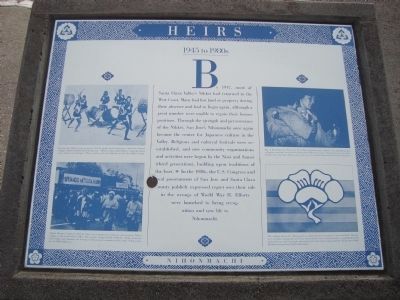
Photographed By Barry Swackhamer, January 30, 2012
4. Nihonmachi Marker - Heirs (Panel 4)
[Photo captions, clockwise from the top left:]
The San Jose Tiako Group, formed in 1973 by mostly Sansei musicians, blends the rhythms of Japan with the rhythms found in America – African, Latin and Filipino – using the instruments of their ancestral past. (Photo courtesy of Curtis Fukuda and San Jose Tiako Group)
Day of Remembrance. Each year the Nikkei community pays tribute to the 120,000 persons of Japanese ancestry incarcerated during World War II, to ensure that the injustice be neither forgotten nor repeated. (Photo courtesy of Gary Jio and the Nihonmachi Outreach Committee)
The emblem chosen for Nihonmachi is a plum blossom set against a furrowed field. The history of the Nikkei immigrants and their descendants is one of perseverance, symbolized by the plum blossom, and the struggle intimately tied to the land, represented by the furrowed field. (Emblem designed by Pamela Matsuoka)
Nikkei Maturi, began in 1978 by Nisei, was organized to preserve and promote Nikkei culture in the Santa Clara Valley. This annual spring festival celebrates Nikkei creativity and vitality, and continues the heritage of Nihonmachi community-wide events. (Photo courtesy of Nikkei Matsuri)
The San Jose Tiako Group, formed in 1973 by mostly Sansei musicians, blends the rhythms of Japan with the rhythms found in America – African, Latin and Filipino – using the instruments of their ancestral past. (Photo courtesy of Curtis Fukuda and San Jose Tiako Group)
Day of Remembrance. Each year the Nikkei community pays tribute to the 120,000 persons of Japanese ancestry incarcerated during World War II, to ensure that the injustice be neither forgotten nor repeated. (Photo courtesy of Gary Jio and the Nihonmachi Outreach Committee)
The emblem chosen for Nihonmachi is a plum blossom set against a furrowed field. The history of the Nikkei immigrants and their descendants is one of perseverance, symbolized by the plum blossom, and the struggle intimately tied to the land, represented by the furrowed field. (Emblem designed by Pamela Matsuoka)
Nikkei Maturi, began in 1978 by Nisei, was organized to preserve and promote Nikkei culture in the Santa Clara Valley. This annual spring festival celebrates Nikkei creativity and vitality, and continues the heritage of Nihonmachi community-wide events. (Photo courtesy of Nikkei Matsuri)
Other nearby markers. At least 8 other markers are within walking distance of this marker. Mr. Peckham (a few steps from this marker); Issei Voices (within shouting distance of this marker); Taihei Hotel (within shouting distance of this marker); Tom & Mary’s Snack Shop & Dr. Watanabe’s Office (within shouting distance of this marker); Jackson Drugs (within shouting distance of this marker); Dobashi Market (within shouting distance of this marker); Kawakami Building (within shouting distance of this marker); Hori Midwife House (within shouting distance of this marker). Touch for a list and map of all markers in San Jose.
Also see . . .
1. The Exclusion of the Ethnic Japanese from the US West Coast in 1942. (Submitted on February 10, 2012, by Barry Swackhamer of Brentwood, California.)
2. Return to the Valley. After World War II ended, Japanese Americans returned at a time when there was a scarcity of labor. Many who ran their own farms had to become migrant farm workers. Those who had strong friendships with local families who promised to care for their land and property found their farms intact. (Submitted on February 12, 2012.)
Credits. This page was last revised on February 7, 2023. It was originally submitted on February 10, 2012, by Barry Swackhamer of Brentwood, California. This page has been viewed 1,112 times since then and 19 times this year. Photos: 1, 2, 3, 4, 5, 6, 7, 8, 9. submitted on February 10, 2012, by Barry Swackhamer of Brentwood, California. • Syd Whittle was the editor who published this page.
